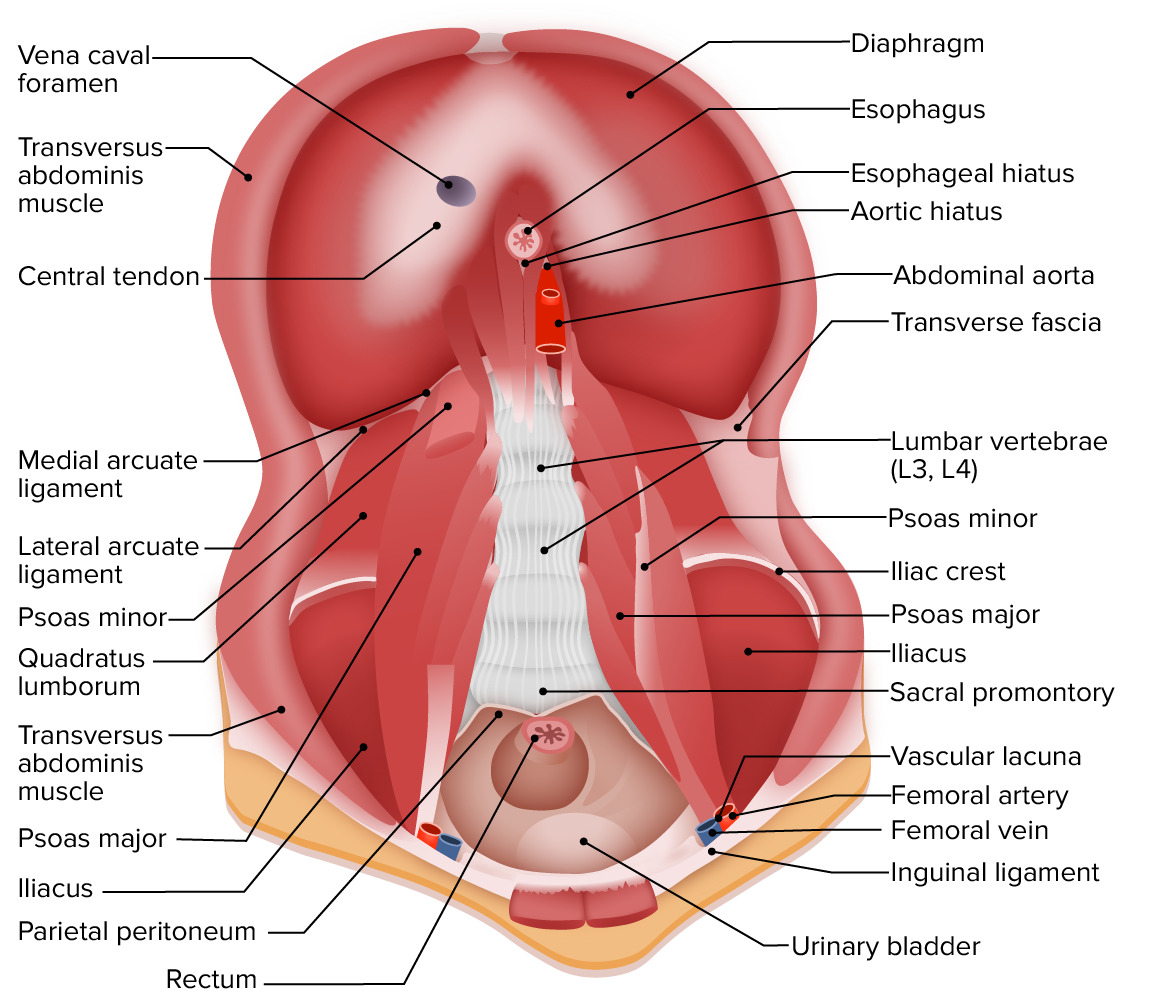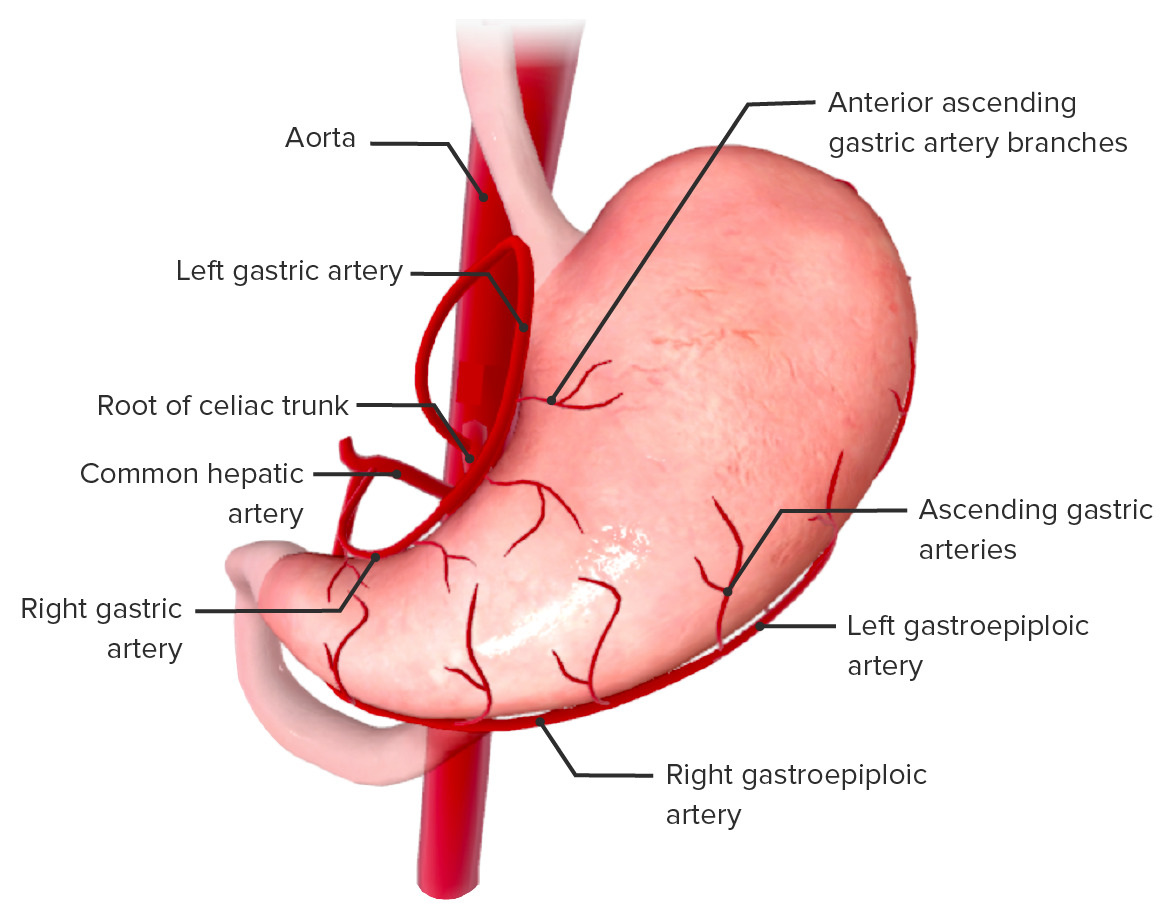Playlist
Show Playlist
Hide Playlist
Autonomic Innervation of the Foregut and Midgut
-
Slides Autonomic Innervation of the Foregut and Midgut.pdf
-
Download Lecture Overview
00:01 So, now let's have a look at the complex autonomic innervation of the organs within the foregut to midgut. 00:07 And then we'll look at the hindgut and the pelvic organs as well. 00:10 There is a lot of detail in here and you may not need to understand all of the minutiae of this detail. 00:17 So let's try and summarize on the images we have the main key points. 00:22 So, here we're looking at the stomach a key organ within the foregut, and we can see the celiac plexus. 00:28 We can see associated the celiac plexus are a number of contributing nerves that supply organs within the foregut. 00:35 So, you'll see, you have the anterior gastric nerve, the pyloric branch of the anterior vagal trunk hepatic branch for example. Lots of branches, which you may or may not need to know the complete detail. 00:48 But these are coming from the anterior vagal trunk. 00:51 This is the left vagus nerves equivalent within the abdomen. 00:57 We also have a posterior vagal trunk and that's contributing from the right vagus nerve. 01:02 And these are ultimately all giving branches that supply organs within the foregut and forming the celiac plexus. 01:10 The celiac plexus is going to be formed via these branches of the vagal trunks. 01:15 And also the sympathetic nerves via the great splanchnic nerves that come from the sympathetic trunk and form the sympathetic celiac ganglion. 01:25 So the celiac ganglion and all of these parasympathetic fibers are forming the celiac plexus. 01:31 This will be the main autonomic hub for the foregut organs. 01:35 We can see running around from the celiac plexus, a superior gastric plexus, an inferior gastric plexus, and hepatic plexus. 01:44 Where we've got mixed fibers of both autonomic and parasympathetic in nature supplying these organs. 01:51 Like I say this is a completely in depth view at looking at all of these autonomic nerves. 01:57 So, please bear in mind, you may not need to know this in as much detail. 02:02 Here we can see that sitting behind the stomach we have the spleen. 02:05 So we'll have a splenic plexus that takes autonomic fibers towards the spleen. 02:10 Here we can see the celiac ganglion in more detail receiving contribution from the greater splanchnic nerve and we can see the anterior and posterior vagal trunk passing through that celiac ganglion to form the celiac plexus. 02:22 From this plexus, we have the hepatic plexus going towards the liver and gallbladder. 02:28 the gastric plexus going towards the stomach. 02:30 The pancreatic plexus going towards the pancreas and the duodenum. 02:34 And the splenic plexus going towards the spleen. 02:37 This is the key take home summary slide of the foregut innovation. 02:42 Greater splanchnic nerve contributing sympathetic. 02:45 Anterior and posterior vagal trunks taking parasympathetic. 02:48 Around the celiac plexus, which gives rise to specific organ plexi that innovate those organs. 02:55 A similar approach towards the midgut. 02:58 We've got some details here around here. 03:00 We see the small intestine. 03:02 We've got two thirds of the large intestine up to the last third of the transverse colon. 03:08 And we can see that it's going to be supplied primarily via this superior mesenteric plexus. 03:13 It's going to have the superior mesenteric ganglion embedded within it. 03:17 But here we've also got a connection from the celiac plexus of the vagus nerve. 03:22 That's followed the aorta all the way down to the superior mesenteric plexus. 03:27 So continuity of the vagus nerve supplying the midgut. 03:31 Here now we can see the lesser splanchnic nerve contributing to the superior mesenteric ganglion. 03:36 And this is combining to form that superior mesenteric plexus associated with the superior mesenteric plexus is going to be that periarterial plexuses that are running alongside the arterial supply to the target organs. We mentioned those previously. 03:53 The best way for these autonomic nerves to pass through the organ is to piggyback alongside the blood vessels. 03:59 So here we can see the superior mesenteric ganglion. 04:02 It's formed right the lesser splanchnic nerve sympathetically and the vagus nerve is contributed down from the celiac plexus to the superior mesenteric plexus. 04:12 Here we then pass towards the small intestine, and the vast majority up to two thirds of the large intestine.
About the Lecture
The lecture Autonomic Innervation of the Foregut and Midgut by James Pickering, PhD is from the course Lymphatics and Nerves of Abdominopelvic Region.
Included Quiz Questions
What contributes to the sympathetic aspect of the celiac plexus?
- Greater splanchnic nerves
- T3 - T8
- Lesser splanchnic nerves
- Least splanchnic nerves
- T6 - L1
What contributes to the parasympathetic aspect of the celiac ganglion?
- Anterior and posterior vagal trunks
- Lateral and medial vagal trunks
- Superior and inferior vagal trunks
- Greater splanchnic nerve
- Lesser splanchnic nerve
Customer reviews
5,0 of 5 stars
| 5 Stars |
|
5 |
| 4 Stars |
|
0 |
| 3 Stars |
|
0 |
| 2 Stars |
|
0 |
| 1 Star |
|
0 |







